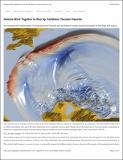| dc.contributor.author | Lopez-Venegas, Alberto | |
| dc.contributor.author | Chacon-Barrantes, Silvia | |
| dc.contributor.author | Zamora, Natalia | |
| dc.contributor.author | Macías - Sánchez, Jorge | |
| dc.date.accessioned | 2020-09-16T16:24:31Z | |
| dc.date.available | 2020-09-16T16:24:31Z | |
| dc.date.issued | 2018-10-04 | |
| dc.identifier.uri | http://hdl.handle.net/11056/18175 | |
| dc.description.abstract | El Caribe es conocido por sus playas tropicales y centros de surf, pero no está exento de terremotos y tsunamis. Durante los últimos 500 años, esta región puede haber estado expuesta a aproximadamente 100 tsunamis, de los cuales se ha confirmado que 20 han causado daños importantes [ Centros Nacionales de Información Ambiental , 2017].
Esta frecuencia relativamente alta, una cada 25 años, es digna de mención porque la región del Caribe alberga a unos 40 millones de personas, con una infraestructura costera, una industria turística y una población en crecimiento. Es especialmente preocupante cómo la naturaleza cerrada de la cuenca del Caribe significa que las olas del tsunami pueden llegar a las costas en tan solo unos minutos a 3 a 4 horas, en contraste con las 15 a 20 horas que puede tomar un tsunami para cruzar el Pacífico. cuenca. | es_ES |
| dc.description.abstract | The Caribbean is known for its tropical beaches and surfing centers, but it is not exempt from earthquakes and tsunamis. During the last 500 years, this region may have been exposed to approximately 100 tsunamis, of which 20 have been confirmed to have caused significant damage [National Environmental Information Centers, 2017].
This relatively high frequency, one every 25 years, is noteworthy because the Caribbean region is home to some 40 million people, with a coastal infrastructure, a tourism industry and a growing population. Of particular concern is how the closed nature of the Caribbean Basin means that tsunami waves can reach shores in as little as a few minutes to 3 to 4 hours, in contrast to the 15 to 20 hours it can take for a tsunami to cross the Peaceful. basin. | es_ES |
| dc.language.iso | eng | es_ES |
| dc.publisher | AGU.ORG | es_ES |
| dc.rights | Acceso abierto | es_ES |
| dc.rights.uri | http://creativecommons.org/publicdomain/zero/1.0/ | * |
| dc.source | EOS 99 1-5 2018 | es_ES |
| dc.subject | MÉTODOS DE SIMULACIÓN | es_ES |
| dc.subject | TSUNAMIS | es_ES |
| dc.subject | ANÁLISIS | es_ES |
| dc.subject | CARIBBEAN | es_ES |
| dc.subject | RISK MITIGATION | es_ES |
| dc.subject | RISK MANAGEMENT | es_ES |
| dc.subject | DISASTER PREVENTION | es_ES |
| dc.title | Nations work together to size up Caribbean tsunami hazards | es_ES |
| dc.type | http://purl.org/coar/resource_type/c_1843 | es_ES |
| una.vi.codigo | SIA 0039-19 | es_ES |
| dc.description.procedence | Departamento de Física | es_ES |
| dc.identifier.doi | https://doi.org/10.1029/2018EO105609 | |


